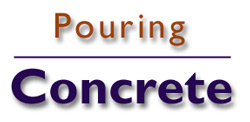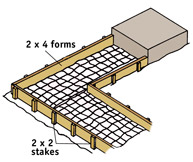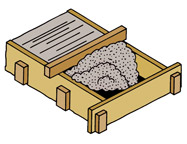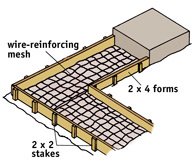 |
||
 |
||
|
|
||
| Here are tips and instructions on working with concrete. Take the time to read these directions thoroughly; following them can save you time and effort. It can also help you end up with a neater, more satisfactory installation–with far less waste.
In this document you will find information about:
|
|
|
 |

DETERMINING THE TYPE OF CONCRETE TO USE
|
|
|
|
|
FIG. 1 - Measure a cubic foot of sand or concrete with a wooden box measuring 12" x 12" x 12". |

MIXING YOUR OWN CONCRETE
|
|
|
|
 |

ESTIMATING THE MATERIALS NEEDED
|
||||||||||||||||||||||||||||||||||||||||||||||||||||||
|
|
|||||||||||||||||||||||||||||||||||||||||||||||||||||||
|
FIG. 3 - Build forms to the shape and size needed for your job. |

BUILDING THE FORMS FOR POURING CONCRETE
|
|
|
|
|
 FIG. 5 - Use a 2x8 plank as a straightedge to guide a concrete groover. 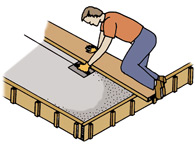 FIG. 6 - Draw the groover along the edge of a 2 x 8 to create contraction joints. 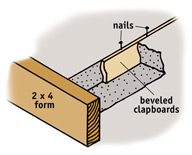 FIG. 7 - Create expansion joints on large concrete areas by using clapboard siding. |

POURING CONCRETE
|
|
|
|
|
|

REINFORCING CONCRETE
|
|
|
|
|
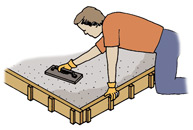 FIG. 10 - Use a steel finishing trowel to give the concrete a smooth, even surface. 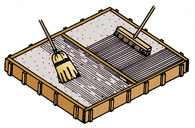 FIG. 11 - Different brooms will create different finishes on concrete surfaces. 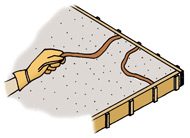 FIG. 12 - Use a 1/2" or 3/4" copper pipe that is slightly bent to create a flagstone pattern. |

DIFFERENT WAYS TO FINISH CONCRETE
|
|
|
|

|

LETTING THE CONCRETE CURE
|
|
|
|
Level
Darby or Float
Hatchet
Tiling Spade
Groover
Long 2x4s for Screed
Line
Brush or Broom
Concrete Hoe
Plastic or Galvanized Pail
2x4s and Other Material for Forms
Edger
Rubber Boots
Line Level
Reinforcing Mesh
Trowel
| Check your state and local codes before starting any project. Follow all safety precautions. Information in this document has been furnished by the National Retail Hardware Association (NRHA) and associated contributors. Every effort has been made to ensure accuracy and safety. Neither NRHA, any contributor nor the retailer can be held responsible for damages or injuries resulting from the use of the information in this document. | |
